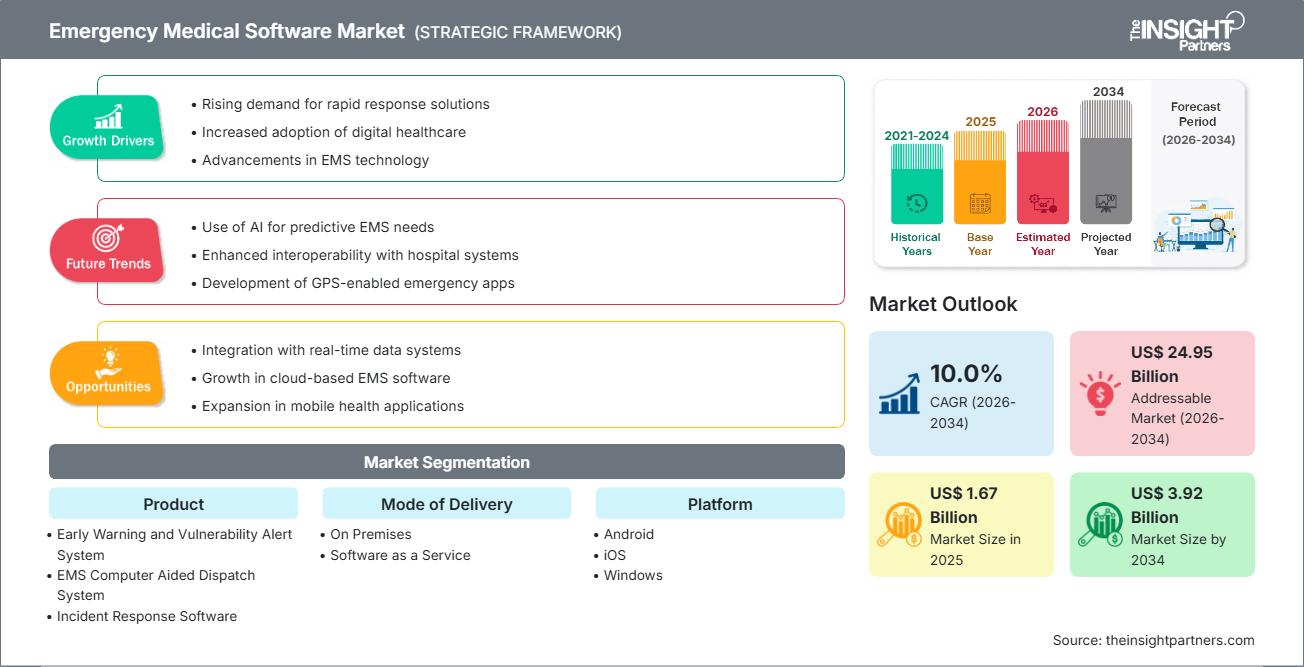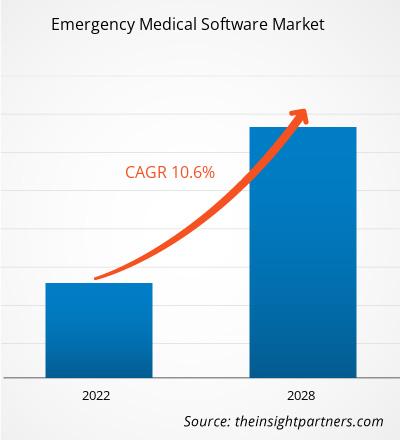Der Markt für Notfallmedizin-Softwaresysteme wird bis 2034 voraussichtlich ein Volumen von 3,92 Milliarden US-Dollar erreichen, gegenüber 1,67 Milliarden US-Dollar im Jahr 2025. Es wird erwartet, dass der Markt im Zeitraum 2026–2034 eine durchschnittliche jährliche Wachstumsrate (CAGR) von 10,0 % verzeichnen wird.
Marktanalyse für Notfallmedizinische Software
Der Markt für Notfallmedizin-Software wächst rasant, angetrieben durch die steigende Zahl von Traumata, zunehmende Gesundheitsausgaben und den wachsenden Bedarf an schnellen und koordinierten Notfallreaktionssystemen. Technologien wie computergestützte Einsatzleitsysteme (CAD), Rettungswagenmanagement-Software, Frühwarn- und Alarmsysteme, Software für die Einsatzreaktion, On-Premise- und SaaS-Bereitstellungsmodelle sowie mobile Plattformen finden immer häufiger Anwendung.
Marktübersicht für Notfallmedizinische Software
Die Implementierung von Notfallmedizin-Software ermöglicht es Krankenhäusern, Gesundheitsdienstleistern, Rettungsdiensten sowie kommunalen und staatlichen Behörden, ihre Abläufe zu optimieren – beispielsweise die Einsatzleitung, das Rettungswagenmanagement, die Patientenverfolgung, die Abrechnung, die Datenerfassung und die Kommunikation zwischen den verschiedenen Einrichtungen. Da die Versorgung von Traumata und Notfällen zeitkritisch ist, tragen diese Softwaresysteme dazu bei, die Reaktionszeit zu verkürzen, die verschiedenen Akteure (Ersthelfer, Krankenhäuser, Transportdienste) zu koordinieren, Ressourcen effizienter zu verwalten und wichtige Patientendaten für bessere Behandlungsergebnisse zu erfassen. Mit der zunehmenden Digitalisierung des Gesundheitswesens, mobilen Plattformen und Cloud-/SaaS-Bereitstellungsmodellen steigt auch die Nachfrage nach leistungsstarken Notfallmedizin-Softwarelösungen kontinuierlich.
Passen Sie diesen Bericht Ihren Anforderungen an.
Sie erhalten eine kostenlose Anpassung aller Berichte – einschließlich Teilen dieses Berichts, Länderanalysen und Excel-Datenpaketen – sowie attraktive Angebote und Rabatte für Start-ups und Universitäten.
Markt für Notfallmedizinische Software: Strategische Einblicke

-
Ermitteln Sie die wichtigsten Markttrends dieses Berichts.Diese KOSTENLOSE Probe beinhaltet eine Datenanalyse, die von Markttrends bis hin zu Schätzungen und Prognosen reicht.
Markttreiber und Chancen für Notfallmedizinische Software
Markttreiber:
- Die weltweit zunehmende Zahl von Traumata und medizinischen Notfällen führt zu einer steigenden Nachfrage nach Software für koordinierte Notfallmaßnahmen.
- Steigende Gesundheitsausgaben und ein Fokus auf die Verbesserung der medizinischen Notfallinfrastruktur, insbesondere in Ländern mit niedrigem und mittlerem Einkommen.
- Die rasche Einführung digitaler Gesundheits-, Mobil- und Cloud-Lösungen durch Rettungsdienste und Krankenhäuser macht den Softwareeinsatz praktikabler und skalierbarer.
Marktchancen:
- Die Bereitstellung von Notfallmedizin-Software über Cloud-Plattformen und SaaS könnte skalierbare und kostengünstige Lösungen bieten, insbesondere für Kommunen und kleinere Rettungsdienste.
- Die Integration fortschrittlicher Technologien wie KI und mobiler Plattformen in Notfallmedizin-Software stellt eine vielversprechende Chance dar.
- Die Expansion in aufstrebende Märkte, in denen die EMS-Infrastruktur modernisiert wird, bietet Softwareanbietern Wachstumspotenzial.
Marktbericht für Notfallmedizinische Software: Segmentierungsanalyse
Der Marktanteil von Notfallmedizin-Software wird in verschiedenen Segmenten analysiert, um ein besseres Verständnis seiner Struktur, seines Wachstumspotenzials und der sich abzeichnenden Trends zu ermöglichen. Nachfolgend ist der in den meisten Branchenberichten verwendete Standard-Segmentierungsansatz dargestellt:
Nach Produkt-/Softwaretyp:
- Frühwarn- und Schwachstellenwarnsystem: Ermöglicht die frühzeitige Erkennung kritischer Ereignisse, alarmiert Gesundheitsdienstleister und unterstützt eine proaktive Reaktion auf Notfälle und Katastrophensituationen.
- Computergestütztes Einsatzleitsystem für Rettungsdienste: Automatisiert die Einsatzleitung, verfolgt Notrufe, weist Ressourcen zu und verbessert die Echtzeit-Koordination zwischen Leitstellenmitarbeitern, Rettungswagen und Krankenhäusern.
- Incident-Response-Software: Optimiert die Koordination bei Notfällen durch die Verwaltung der Kommunikation, den Datenaustausch und die Aufgabenverteilung zwischen mehreren Einsatzteams und medizinischen Einrichtungen.
- Ambulanzmanagement-Software: Optimiert die Ambulanzortung, Routenplanung, Ressourcenzuweisung und Patientendatenverwaltung für eine schnellere und effizientere medizinische Notfallversorgung.
Per Modem der Zustellung:
- Vor Ort: Wird lokal innerhalb der Infrastruktur des Gesundheitswesens oder des Rettungsdienstes eingesetzt und bietet vollständige Datenkontrolle, hohe Sicherheit und anpassbare Betriebskonfigurationen.
- Software as a Service: Cloudbasierte Lösung, die Echtzeitzugriff, Skalierbarkeit, Remote-Updates und kosteneffiziente Bereitstellung in verteilten EMS-Netzwerken bietet.
Nach Plattform:
- Android
- iOS
- Windows
Vom Endbenutzer:
- Kommerziell
- Gemeinde
- Staatliche Stadtbehörden
Nach Geographie:
- Nordamerika
- Europa
- Asien-Pazifik
- Süd- und Mittelamerika
- Naher Osten und Afrika
Markt für Notfallmedizinische Software: Regionale Einblicke
Die regionalen Trends und Einflussfaktoren auf den Markt für Notfallmedizin-Software im gesamten Prognosezeitraum wurden von den Analysten von The Insight Partners eingehend erläutert. Dieser Abschnitt behandelt außerdem die Marktsegmente und die geografische Verteilung des Marktes für Notfallmedizin-Software in Nordamerika, Europa, Asien-Pazifik, dem Nahen Osten und Afrika sowie Süd- und Mittelamerika.
Berichtsumfang zum Markt für Notfallmedizinische Software
| Berichtattribute | Details |
|---|---|
| Marktgröße im Jahr 2025 | 1,67 Milliarden US-Dollar |
| Marktgröße bis 2034 | 3,92 Milliarden US-Dollar |
| Globale durchschnittliche jährliche Wachstumsrate (2026 - 2034) | 10,0 % |
| Historische Daten | 2021-2024 |
| Prognosezeitraum | 2026–2034 |
| Abgedeckte Segmente |
Nebenprodukt
|
| Abgedeckte Regionen und Länder |
Nordamerika
|
| Marktführer und wichtige Unternehmensprofile |
|
Marktdichte der Anbieter von Notfallmedizin-Software: Auswirkungen auf die Geschäftsdynamik verstehen
Der Markt für Notfallmedizin-Software wächst rasant, angetrieben durch die steigende Nachfrage der Endnutzer. Gründe hierfür sind unter anderem sich wandelnde Verbraucherpräferenzen, technologische Fortschritte und ein wachsendes Bewusstsein für die Vorteile der Produkte. Mit steigender Nachfrage erweitern Unternehmen ihr Angebot, entwickeln innovative Lösungen, um den Bedürfnissen der Verbraucher gerecht zu werden, und nutzen neue Trends, was das Marktwachstum zusätzlich beflügelt.

- Verschaffen Sie sich einen Überblick über die wichtigsten Akteure auf dem Markt für Notfallmedizinische Software.
Marktanteilsanalyse für Notfallmedizin-Software nach Regionen
Nordamerika hielt den größten Marktanteil, bedingt durch steigende Notrufzahlen, die wachsende Nachfrage nach betrieblicher Effizienz und sich wandelnde regulatorische Anforderungen, die fortschrittliche Abrechnungs- und Managementlösungen in den Vordergrund stellen. Der asiatisch-pazifische Raum dürfte hingegen das schnellste Wachstum verzeichnen, unterstützt durch die rasche Modernisierung der Gesundheitsinfrastruktur, die verstärkte Inanspruchnahme von Notfalldiensten und beschleunigte Initiativen zur digitalen Transformation in den Gesundheitssystemen der Region.
Der Markt für Notfallmedizin-Software weist aufgrund von Faktoren wie der steigenden Zahl von Traumata und den zunehmenden Gesundheitsausgaben in den einzelnen Regionen unterschiedliche Wachstumsverläufe auf. Nachfolgend finden Sie eine Zusammenfassung der Marktanteile und Trends nach Regionen:
1. Nordamerika
- Marktanteil: Traditionell führend auf dem Markt für Notfallmedizin-Software aufgrund fortschrittlicher EMS-Infrastruktur, hoher Digitalisierung, einer großen Anzahl von EMS-Einsätzen und starker Investitionen in die IT des Gesundheitswesens.
- Wichtigste Einflussfaktoren: Hohe Akzeptanz von EMS-Softwarelösungen, Präsenz großer Software- und EMS-Anbieter, starkes regulatorisches und finanzielles Umfeld für Notfallversorgungstechnologien.
- Trends: Zunehmender Einsatz von mobilen Leitstellen, Cloud-/SaaS-Rettungsdienstsystemen, Interoperabilität mit Krankenhaus- und Transportsystemen.
2. Europa
- Marktanteil: Bedeutender Markt aufgrund etablierter Gesundheitssysteme und regulatorischer Bestrebungen für digitale Rettungsdienste und IT-Lösungen im Gesundheitswesen.
- Wichtigste Einflussfaktoren: Regulierungsinitiativen, Finanzierung von Modernisierungen des Rettungsdienstes und grenzüberschreitende Zusammenarbeit im Rettungsdienst in bestimmten Regionen.
- Trends: Einführung von Cloud-basierten EMS-Lösungen, mehrsprachige Plattformunterstützung, verstärkte Integration von Flotten- und Rettungswagenmanagement.
3. Asien-Pazifik
- Marktanteil: Schnell wachsende Region, angetrieben durch die Modernisierung der EMS-Infrastruktur, steigende Trauma-/Unfallraten und die zunehmende Nutzung von IT im Gesundheitswesen in Ländern wie Indien, China und Südostasien.
- Wichtigste Einflussfaktoren: Regierungsinitiativen im Bereich der digitalen Gesundheitsversorgung, zunehmende Verbreitung von Smartphones/Mobiltelefonen für die Kommunikation im Rettungsdienst und vermehrte private Rettungsdienste.
- Trends: Mobile-First-Software für die Einsatzleitung und die Verfolgung von Rettungswagen, Partnerschaften mit regionalen Rettungsdienstanbietern, mobile Apps für die Notfallversorgung.
4. Süd- und Mittelamerika
- Marktanteil: Aufstrebende Region mit wachsenden Investitionen in EMS-Technologie und zunehmendem Einsatz privater EMS-Anbieter.
- Wichtigste Einflussfaktoren: Zunehmende Nutzung von Dispatch- und Rettungswagenmanagement-Software durch private Rettungsdienstanbieter, Modernisierung der regionalen Rettungsdienstinfrastruktur.
- Trends: Cloudbasierte EMS-Softwaremodelle, die sich für budgetbeschränkte Organisationen eignen, steigende Nachfrage nach Fahrzeugortungs- und Patientendatensatzlösungen.
5. Naher Osten und Afrika
- Marktanteil: Aufstrebend mit Wachstumspotenzial, da Regierungen in Rettungsdienste und digitale Gesundheitsversorgung investieren.
- Wichtigste Einflussfaktoren: Nationale Initiativen im Bereich des Rettungsdienstes, das Wachstum privater Rettungsdienste und die zunehmende Verbreitung digitaler Einsatzleit- und Rettungswagensoftware.
- Trends: Software-Suiten, die auf den mehrsprachigen/multikulturellen Einsatz von Rettungsdiensten zugeschnitten sind, mobile Rettungsdienst-Einsatzleitstellenlösungen, Integration mit Telemedizin- und Versicherungssystemen.
Marktdichte der Anbieter von Notfallmedizin-Software: Auswirkungen auf die Geschäftsdynamik verstehen
Der Markt für Notfallmedizin-Software ist durch den verstärkten Wettbewerb zwischen großen globalen Technologieanbietern und aufstrebenden Nischenanbietern sowie spezialisierten Startups geprägt. Unternehmen investieren aktiv in Innovationen, um ihre Marktposition zu stärken und die wachsende Nachfrage nach intelligenten Entscheidungsplattformen branchenübergreifend zu decken.
Der Wettbewerb zwingt die Anbieter dazu, sich durch Folgendes zu differenzieren:
- Die großen Anbieter treiben die Expansion durch Innovationen, Cloud-Bereitstellungsmodelle, mobile Plattformen und Analysen voran.
- Die Differenzierung erfolgt durch Softwarefunktionen für die Einsatzkoordination, die Verfolgung von Rettungswagen, den Echtzeit-Datenaustausch, die Abrechnung und das Berichtswesen für Rettungsdienste.
- Regulatorische Standards und Interoperabilitätsstandards gewinnen zunehmend an Bedeutung; Anbieter, die skalierbare, konforme Lösungen anbieten, können sich mehr Chancen sichern.
Chancen und strategische Schritte
- Softwareanbieter für Rettungsdienste können die wachsende Nachfrage nach hypervernetzten Echtzeit-Rettungsdienstsystemen nutzen, die Einsatzleitung, Rettungswagenmanagement, Krankenhauskommunikation, Patientendatenerfassung und Ergebnisverfolgung integrieren.
- Die Einführung cloudbasierter Bereitstellungsmethoden ermöglicht es kleineren Rettungsdiensten/Kommunen, fortschrittliche Software ohne signifikante Vorabinvestitionen in die Infrastruktur einzuführen.
- Die Expansion in aufstrebende Märkte mit unzureichender EMS-Infrastruktur birgt ein hohes Wachstumspotenzial – Anbieter können Partnerschaften mit lokalen EMS-Organisationen oder Regierungen eingehen.
- Die Integration von KI und Analytik in die EMS-Software für vorausschauende Einsatzplanung, Ressourcenoptimierung, Patiententriage und Ergebnismessung kann neue Wertversprechen schaffen.
Die wichtigsten Unternehmen auf dem Markt für Notfallmedizinische Software sind:
- Quark Software
- Sun Ridge Systems, Inc.
- Trapezgruppe
- Cerner Corporation
- GE Healthcare
- Zentralplatz
- Traumasoft
- AngelTrack LLC
- EMIS Health
- MEDHOST
Neuigkeiten und aktuelle Entwicklungen auf dem Markt für Notfallmedizinische Software
- Beispielsweise gab MEDHOST, ein führender Anbieter von EHR- und IT-Lösungen für das Gesundheitswesen, heute, am 6. November 2025, die allgemeine Verfügbarkeit von EDIS 2024 R1 bekannt. Diese neueste Version bietet bedeutende Verbesserungen zur Optimierung klinischer Arbeitsabläufe, zur Verbesserung der Interoperabilität und zur Angleichung an die neuesten bundesstaatlichen Datenstandards im Gesundheitswesen.
- Am 20. Oktober 2025 gab GE HealthCare die Zusammenarbeit mit zwei führenden US-amerikanischen Gesundheitssystemen, darunter The Queen's Health Systems, bekannt. Ziel der Kooperation ist die Weiterentwicklung der neuen KI-gestützten Krankenhausbetriebssoftware von GE HealthCare. Beide Gesundheitssysteme werden ihre praktischen Erfahrungen in die kommende Cloud-basierte Software-as-a-Service-Lösung von GE HealthCare einbringen, die Teil der CareIntellect-Anwendungsfamilie von GE HealthCare sein wird.
- Im Januar 2024 stärkte die N. Harris Computer Corporation, ein globaler Anbieter von Branchensoftware, ihr Portfolio im Gesundheitswesen durch die Übernahme von MEDHOST, Inc., einem führenden Anbieter von elektronischen Patientenakten (EHR) und IT-Lösungen für das Gesundheitswesen. Zu dieser Übernahme gehört auch MEDTEAM Solutions, ein Dienstleister, der sich auf Anwendungs-, Abrechnungs-, IT- und Sicherheitsmanagement spezialisiert hat.
Marktbericht für Notfallmedizinische Software: Abdeckung und Ergebnisse
Der Bericht „Marktgröße und Prognose für Notfallmedizinische Software (2021–2034)“ bietet eine detaillierte Analyse des Marktes und deckt folgende Bereiche ab:
- Marktgröße und Prognose für Notfallmedizin-Software auf globaler, regionaler und Länderebene für alle wichtigen Marktsegmente, die im Rahmen des Berichts abgedeckt werden
- Trends im Markt für Notfallmedizin-Software sowie Marktdynamiken wie Treiber, Hemmnisse und wichtige Chancen
- Detaillierte PEST- und SWOT-Analyse
- Marktanalyse für Notfallmedizin-Software: Wichtige Markttrends, globale und regionale Rahmenbedingungen, Hauptakteure, regulatorische Rahmenbedingungen und aktuelle Marktentwicklungen
- Branchenlandschaft und Wettbewerbsanalyse mit Fokus auf Marktkonzentration, Heatmap-Analyse, führende Akteure und aktuelle Entwicklungen im Markt für Notfallmedizin-Software. Detaillierte Unternehmensprofile.
- Historische Analyse (2 Jahre), Basisjahr, Prognose (7 Jahre) mit CAGR
- PEST- und SWOT-Analyse
- Marktgröße Wert/Volumen – Global, Regional, Land
- Branchen- und Wettbewerbslandschaft
- Excel-Datensatz
Aktuelle Berichte
Erfahrungsberichte
Grund zum Kauf
- Fundierte Entscheidungsfindung
- Marktdynamik verstehen
- Wettbewerbsanalyse
- Kundeneinblicke
- Marktprognosen
- Risikominimierung
- Strategische Planung
- Investitionsbegründung
- Identifizierung neuer Märkte
- Verbesserung von Marketingstrategien
- Steigerung der Betriebseffizienz
- Anpassung an regulatorische Trends






















 Kostenlose Probe anfordern für - Markt für Notfallmedizinische Software
Kostenlose Probe anfordern für - Markt für Notfallmedizinische Software